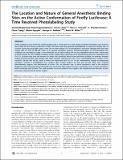| dc.contributor.author | Shanmugasundararaj, Sivananthaperumal | |
| dc.contributor.author | Lehle, Simon | |
| dc.contributor.author | Yamodo, Herve I. | |
| dc.contributor.author | Husain, S. Shaukat | |
| dc.contributor.author | Tseng, Claire | |
| dc.contributor.author | Nguyen, Khanh | |
| dc.contributor.author | Addona, George H. | |
| dc.contributor.author | Miller, Keith Wyatt | |
| dc.date.accessioned | 2013-02-11T21:08:07Z | |
| dc.date.issued | 2012 | |
| dc.identifier.citation | Shanmugasundararaj, Sivananthaperumal, Simon Lehle, Herve I. Yamodo, S. Shaukat Husain, Claire Tseng, Khanh Nguyen, George H. Addona, and Keith W. Miller. 2012. The location and nature of general anesthetic binding sites on the active conformation of firefly luciferase; A time resolved photolabeling study. PLoS ONE 7(1): e29854. | en_US |
| dc.identifier.issn | 1932-6203 | en_US |
| dc.identifier.uri | http://nrs.harvard.edu/urn-3:HUL.InstRepos:10288496 | |
| dc.description.abstract | Firefly luciferase is one of the few soluble proteins that is acted upon by a wide variety of general anesthetics and alcohols; they inhibit the ATP–driven production of light. We have used time–resolved photolabeling to locate the binding sites of alcohols during the initial light output, some 200 ms after adding ATP. The photolabel 3-azioctanol inhibited the initial light output with an IC50 of 200 \(\mu\)M, close to its general anesthetic potency. Photoincorporation of [\(^3\)H]3-azioctanol into luciferase was saturable but weak. It was enhanced 200 ms after adding ATP but was negligible minutes later. Sequencing of tryptic digests by HPLC–MSMS revealed a similar conformation–dependence for photoincorporation of 3-azioctanol into Glu-313, a residue that lines the bottom of a deep cleft (vestibule) whose outer end binds luciferin. An aromatic diazirine analog of benzyl alcohol with broader side chain reactivity reported two sites. First, it photolabeled two residues in the vestibule, Ser-286 and Ile-288, both of which are implicated with Glu-313 in the conformation change accompanying activation. Second, it photolabeled two residues that contact luciferin, Ser-316 and Ser-349. Thus, time resolved photolabeling supports two mechanisms of action. First, an allosteric one, in which anesthetics bind in the vestibule displacing water molecules that are thought to be involved in light output. Second, a competitive one, in which anesthetics bind isosterically with luciferin. This work provides structural evidence that supports the competitive and allosteric actions previously characterized by kinetic studies. | en_US |
| dc.language.iso | en_US | en_US |
| dc.publisher | Public Library of Science | en_US |
| dc.relation.isversionof | doi:10.1371/journal.pone.0029854 | en_US |
| dc.relation.hasversion | http://www.ncbi.nlm.nih.gov/pmc/articles/PMC3260189/pdf/ | en_US |
| dash.license | LAA | |
| dc.subject | biology | en_US |
| dc.subject | biochemistry | en_US |
| dc.subject | proteins | en_US |
| dc.subject | chemistry | en_US |
| dc.subject | medicinal chemistry | en_US |
| dc.subject | medicine | en_US |
| dc.subject | anesthesiology | en_US |
| dc.subject | drugs and devices | en_US |
| dc.subject | neurology | en_US |
| dc.title | The Location and Nature of General Anesthetic Binding Sites on the Active Conformation of Firefly Luciferase; A Time Resolved Photolabeling Study | en_US |
| dc.type | Journal Article | en_US |
| dc.description.version | Version of Record | en_US |
| dc.relation.journal | PLoS ONE | en_US |
| dash.depositing.author | Miller, Keith Wyatt | |
| dc.date.available | 2013-02-11T21:08:07Z | |
| dc.identifier.doi | 10.1371/journal.pone.0029854 | * |
| dash.contributor.affiliated | Miller, Keith | |


